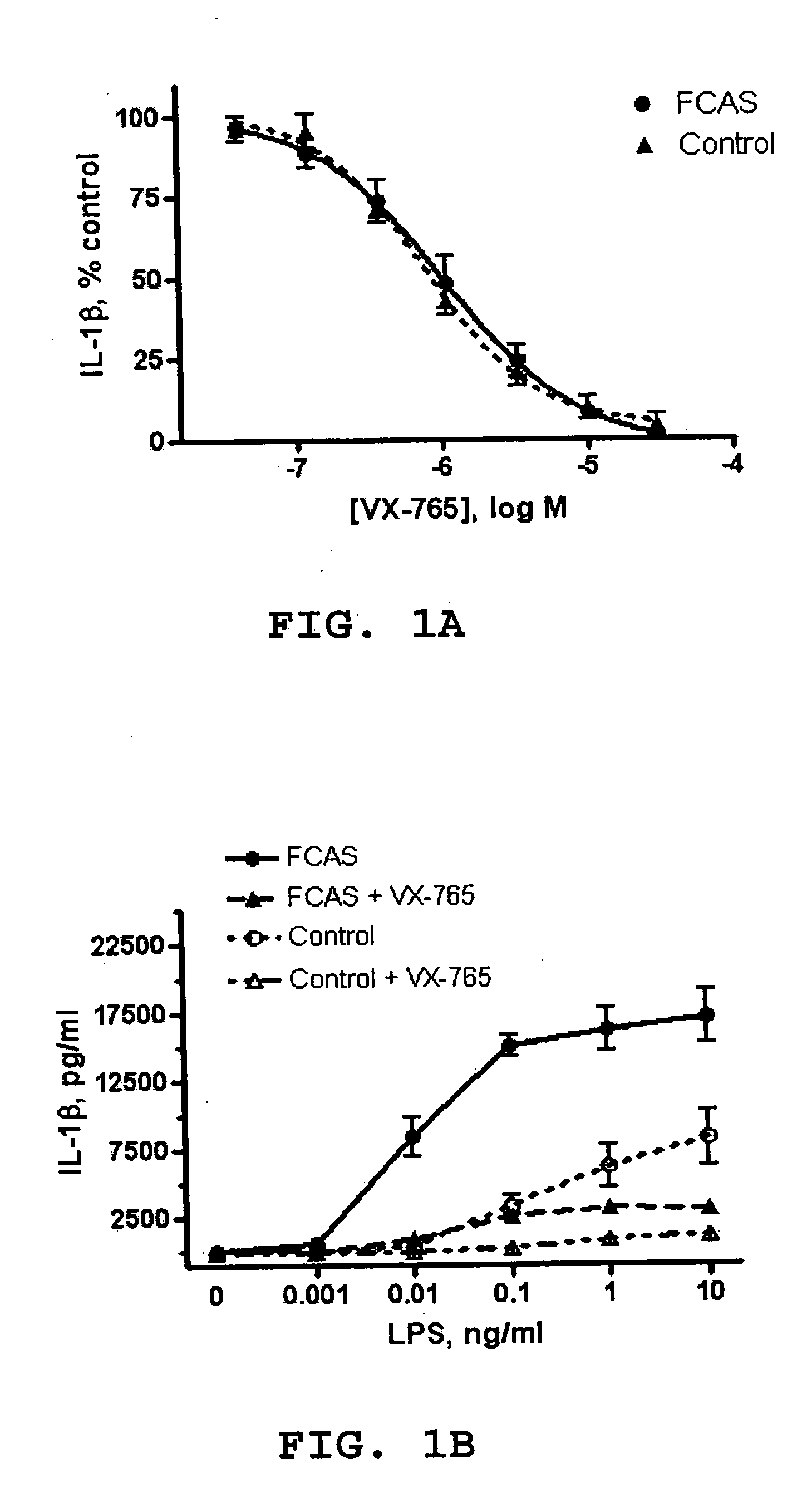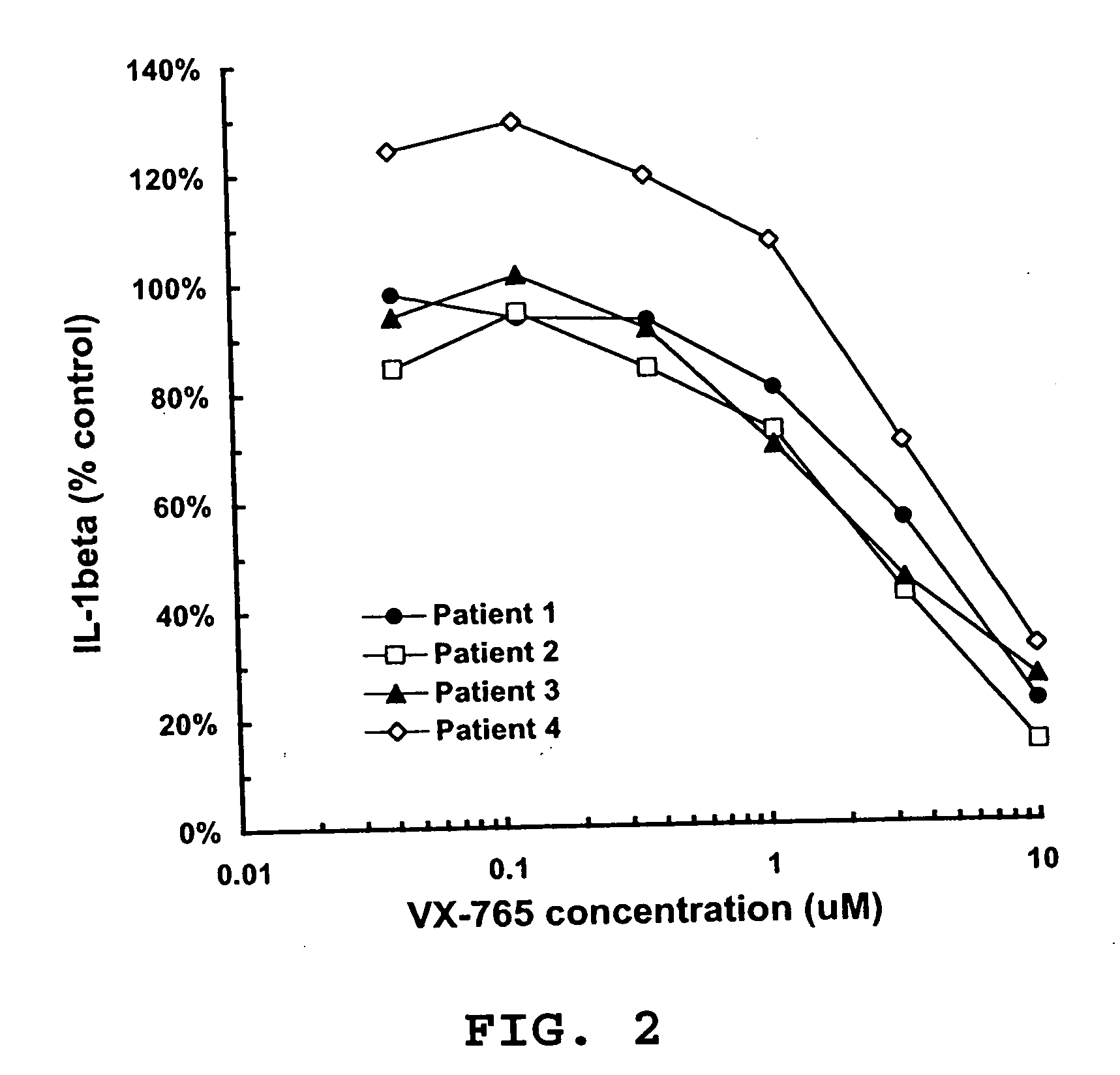Treatment of diseases using ICE inhibitors
- Summary
- Abstract
- Description
- Claims
- Application Information
AI Technical Summary
Benefits of technology
Problems solved by technology
Method used
Image
Examples
example 1
[3S / R, (2S)]-5-Fluoro-4-oxo-3-{[1-(phenothiazine-10-carbonyl)piperidine-2-carbonyl]amino}-pentanoic Acid
[0071]
Method A: (S)-(1-Phenothiazine-10-carbonyl)piperidine-2-carboxylic acid methyl ester
[0072]
[0073] To a stirred solution of methyl pipecolate hydrochloride (1 g, 5.57 mmol) in THF (10 ml) was added phenothiazine carbonyl chloride (1.457 g, 5.57 mmol) followed by diisopropylethylamine (2.02 ml, 11.68 mmol). The resulting solution was stirred for 16 h before being partitioned between ethyl acetate and aq. sat. NH4Cl. The organic layer was washed with brine, dried (MgSO4), filtered and evaporated. The residue was purified by flash chromatography (15% ethyl acetate in hexane) to afford the sub-title compound as a colorless oil which crystallized upon standing (1.823 g, 89%): 1H NMR (400 MHz, CDCl3) δ 1.13-1.48 (3H, m), 2.57-2.69 (2H, m), 2.16 (1H, m), 3.00 (1H, m), 3.74 (4H, s+m), 5.00 (1H, m), 7.11 (2H, t), 7.22-7.34 (4H, m), 7.76 (2H, d); 13C NMR (100 MHz, CDCl3) δ 21.3 (CH2),...
example 2
[3S / R, (2S)]-3-{[1-(2-Chlorophenothiazine-10-carbonyl)piperidine-2-carbonyl]amino}-4-fluoro-4-oxo-pentanoic Acid
[0082]
[0083] This was prepared from 2-chlorophenothiazine carbonyl chloride using procedures similar to those described above in Methods A-E (73 mg, 69%): IR (solid, cm−1) 1738, 1660, 1555, 1363, 1224; 1H NMR (400 MHz, d6-DMSO+TFA) δ 0.98-1.61 (4H, m), 1.94-2.03 (1H, m), 2.53-2.89 (2H, m), 3.12-3.24 (1H, m), 3.51-3.61 (1H, m), 4.31-4.73 and 5.10-5.24 (4H, 2m), 7.15-7.49 (6H, m), 7.77-7.81 (1H, m), 8.13-8.64 (1H, m); 13C NMR (100 MHz, DMSO+TFA) δ 18.7 / 18.8 (CH2), 22.3 / 22.6 (CH2), 25.9 / 26.2 (CH2), 31.5 / 33.2 (CH2), 43.0 / 43.2 (CH2), 50.6 / 51.1 (CH), 54.4 / 54.5 (CH), 82.8 / 82.9 (2d, J 178.7 / 178.3, CH2F), 119.3 / 119.8 (CH), 120.2 / 120.3 (CH), 123.6 / 123.7 (CH), 124.4 / 124.5 (CH), 124.6 / 124.8 (C), 126.6 (CH), 126.9 (CH), 127.5 (CH), 131.0 (C), 139.2 / 139.2 (C), 140.7 / 140.7 (C), 155.5 / 155.9 (C), 170.1 / 170.2 (C), 170.7 / 170.8 (C), 201.2 / 201.3 (2d, J 14.3 / 13.9, CO); 19F NMR (376 MHz, DMSO+T...
example 3
[3S / R, (2S)]-3-{[1-(3-Chlorophenothiazine-10-carbonyl)piperidine-2-carbonyl]amino}-4-fluoro-4-oxo-pentanoic Acid
[0084]
[0085] This was prepared from 3-chlorophenothiazine carbonyl chloride using procedures similar to those described above in Methods A-E (108 mg, 65%): IR (solid, cm−1) 1737, 1655, 1455, 1373, 1224; 1H NMR (400 MHz, d6-DMSO+TFA) δ 0.99-1.61 (5H, m), 1.91-2.04 (1H, m), 2.54-2.90 (2H, m), 3.12-3.24 (1H, m), 3.48-3.60 (1H, m), 4.26-5.28 (4H, m), 7.15-7.68 (7H, m), 8.10-8.62 (1H, m); 13C NMR (100 MHz, DMSO+TFA) δ 18.8 (CH2), 22.2 / 22.3 (CH2), 25.8 (CH2), 33.1 / 33.2 (CH2), 43.2 (CH2), 50.6 / 51.0 (CH), 54.3 / 54.4 (CH), 82.7 / 82.8 (2d, CH2F), 120.2 / 120.3 (CH), 121.3 / 121.4 (CH), 124.2 / 124.3 (CH), 124.8 / 125.0 (C), 125.7 (CH), 126.3 (CH), 126.6 (CH), 126.8 (CH), 127.7 / 127.9 (C), 127.9 / 128.0 (C), 138.5 (C), 139.3 (C), 156.0 (CO), 170.1 (CO), 170.6 / 170.7 (CO), 201.1 / 201.2 (2d, CO); 19F NMR (376 MHz, DMSO+TFA) δ−226.6 (t), −226.9 (t), −232.6 (t), −232.9 (t).
PUM
| Property | Measurement | Unit |
|---|---|---|
| Mass | aaaaa | aaaaa |
| Mass | aaaaa | aaaaa |
| Dimensionless property | aaaaa | aaaaa |
Abstract
Description
Claims
Application Information
 Login to View More
Login to View More - R&D Engineer
- R&D Manager
- IP Professional
- Industry Leading Data Capabilities
- Powerful AI technology
- Patent DNA Extraction
Browse by: Latest US Patents, China's latest patents, Technical Efficacy Thesaurus, Application Domain, Technology Topic, Popular Technical Reports.
© 2024 PatSnap. All rights reserved.Legal|Privacy policy|Modern Slavery Act Transparency Statement|Sitemap|About US| Contact US: help@patsnap.com










